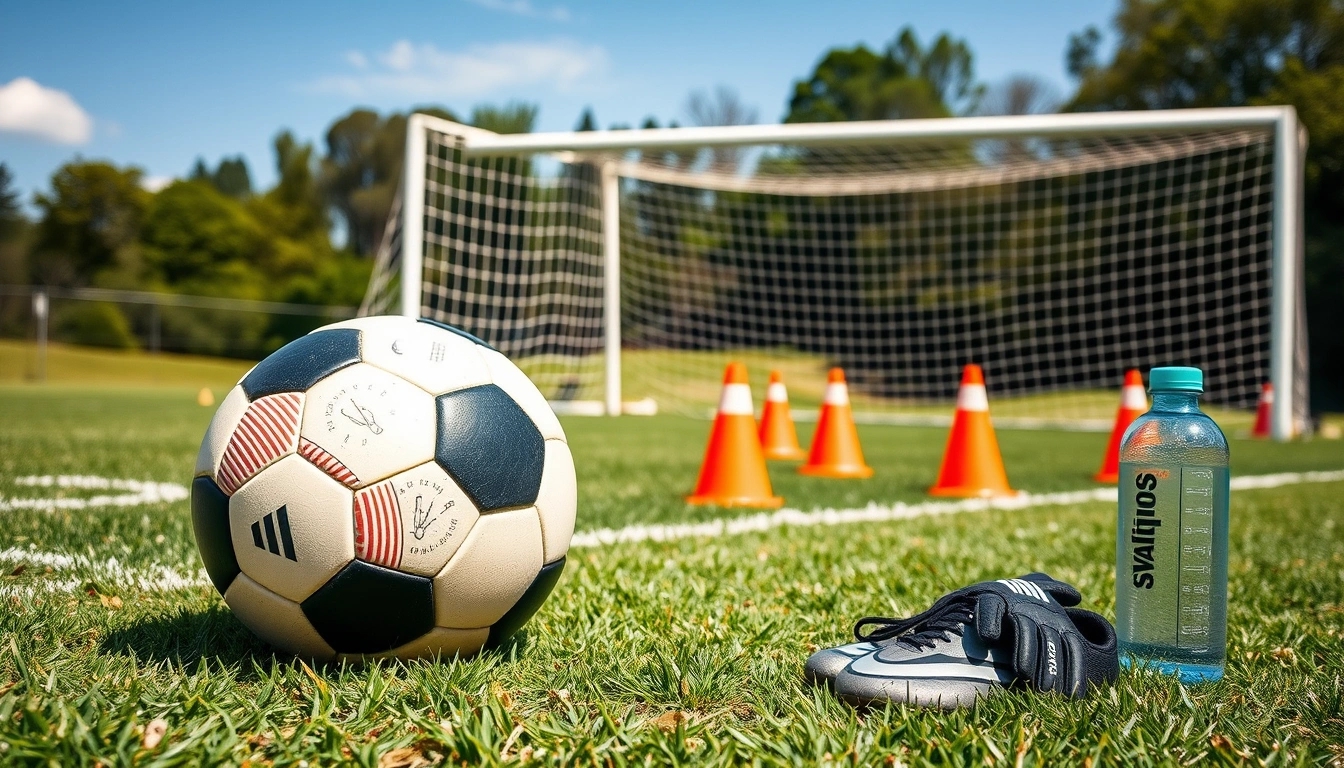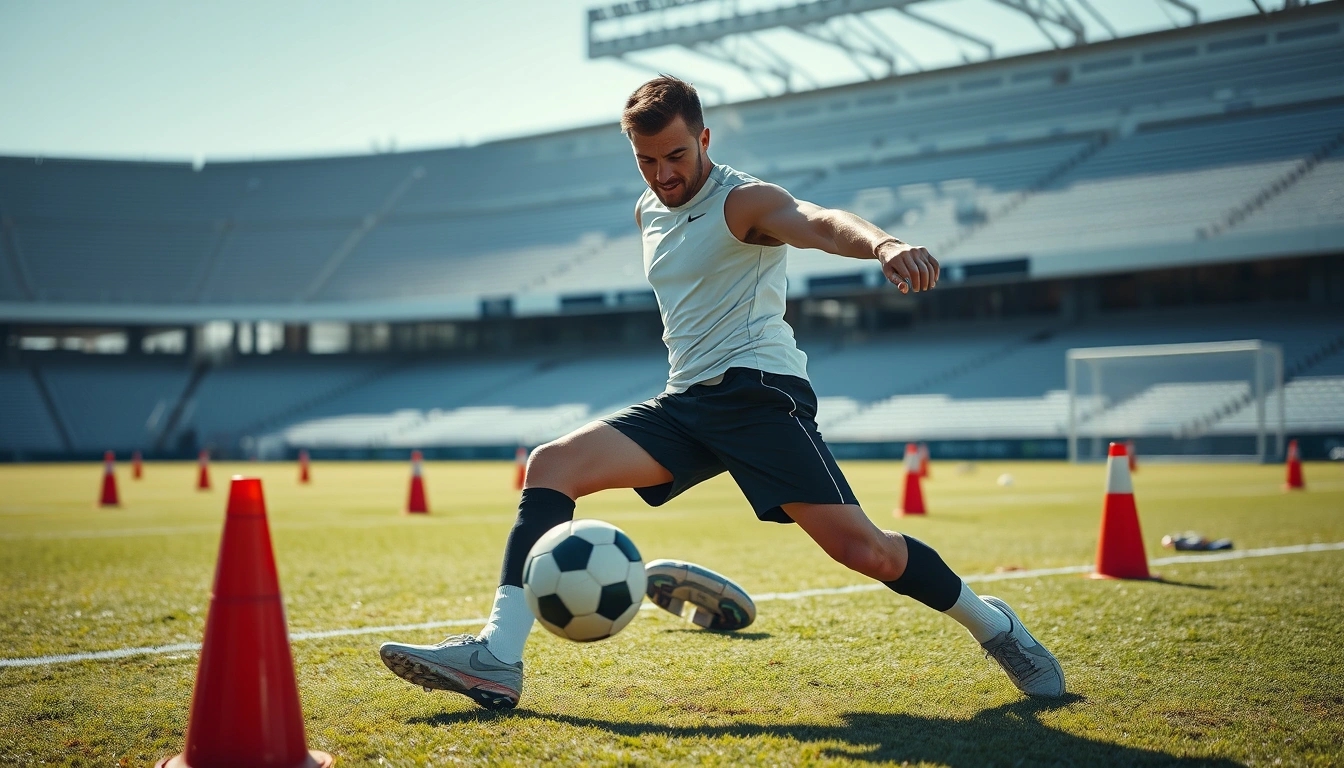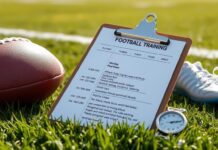Unlocking your inner goal machine isn’t some mystical talent reserved for the Messi’s or Haaland’s of this world. Nope, it’s about grinding it out alone, day in, day out, with solo drills that sharpen not just your finishing skills but also your precision and confidence when you’re staring down the goal with no one else around. Sounds lonely? Maybe. But here’s the kicker — mastering these drills means you’re building muscle memory and instincts that kick in when it really counts. So, let’s break down how you can become a lethal striker, all by yourself.
Why Solo Drills Matter for Strikers
You might be thinking, “Why bother training alone when football is a team sport?” Well, solo drills force you to rely on yourself — no fancy passes, no assists, just you and the ball. This kind of practice sharpens your reaction time and helps develop that killer instinct to place shots perfectly. Plus, when no one’s there to feed you the ball, you learn to create your own chances. It’s like building a striker’s sixth sense.
| Benefits of Solo Drills | Explanation |
|---|---|
| Muscle Memory | Repetition ingrains precise movements for shooting. |
| Confidence Boost | Repeated success in practice builds self-belief. |
| Creativity | Learning to improvise without teammates. |
| Focus on Technique | Allows detailed attention to shooting mechanics. |
Essential Warm-Up Routines Before Solo Practice
Before you start blasting shots like a maniac, warm those muscles up! Skipping warm-ups is like going into battle with no armor — recipe for injury. Focus on dynamic stretches: leg swings, lunges, and some light jogging. Don’t forget ankle rotations — those little joints take a beating when you’re kicking the ball hard.
- Leg Swings: Front-to-back and side-to-side to loosen hips.
- Lunges: Walk forward with deep lunges to stretch quads and glutes.
- Light Jogging: 5 minutes to get blood flowing.
- Ankle Rotations: Both directions, 10 times each foot.
Top 5 Solo Shooting Drills to Boost Accuracy
Alright, now the fun part. Here’s a quick rundown of the best solo drills that’ll sharpen your shot placement and power without needing a teammate.
| Drill | Purpose | How to Do It |
|---|---|---|
| Target Practice with Cones | Improves precision | Set cones in goal corners; aim to hit them consistently. |
| Volley and Half-Volley Practice | Enhances timing and technique | Toss ball up and strike before it hits ground fully. |
| One-Touch Finishing | Quick decision-making | Bounce ball to self and shoot in one motion. |
| Power Shots | Builds shot strength | Focus on striking ball with laces, aiming for distance. |
| Weak Foot Drills | Improves ambidexterity | Repeat shooting exercises with your non-dominant foot. |
Drill 1: Target Practice with Cones
Imagine the goal’s corners dotted with cones — your personal bullseyes. The idea? Hit those cones like you’re sniping from long range. This drill forces you to aim carefully and adjust your foot placement for accuracy. It’s a bit frustrating at first, but trust me, after a few hundred attempts, you’ll swear you’ve got laser-guided feet.
Drill 2: Volley and Half-Volley Practice
Volleys are sexy goals — but nailing them solo is tricky. Toss the ball in the air, time your strike just right, and smash it before it bounces or right after one bounce. It’s all about rhythm and confidence. Don’t worry if you whiff a few times; even pros mess up volleys in training.
Improving Your First Touch Without a Teammate
Your first touch can make or break a scoring chance. Without teammates, use wall passes or bounce the ball off a sturdy surface to practice controlling the ball instantly. The key is to keep the ball close and ready for that deadly shot.
Using Technology to Enhance Solo Training
Tech geeks, rejoice! Apps and gadgets can track shot speed, accuracy, and even provide video feedback. Using a smartphone to record your drills or wearable sensors to analyze your kicking technique can give you insights no coach can when you’re training alone.
Common Mistakes to Avoid When Training Alone
Don’t fall into the trap of overtraining or repeating the same drill till your brain melts. Variety is king — mix up drills, rest properly, and focus on technique over power. Otherwise, you risk injury or plateauing.
Tracking Progress: How to Know You’re Getting Better
Keep a simple log — number of shots on target, successful finishes, or even video clips to compare over time. Celebrate the small wins; they add up faster than you think.
So, there you have it — becoming a clinical striker solo is tough, sure, but with these drills and a bit of stubbornness, you’ll be banging in goals like a pro in no time. Now, lace up and get to work!
Why Solo Drills Matter for Strikers
Alright, let’s cut to the chase—being a striker isn’t just about having a squad of teammates feeding you perfect passes every time. Nope, sometimes you’re out there all alone, staring down the goal like it owes you money. That’s where solo drills come into play, and trust me, they’re more than just a way to kill time. They’re the secret sauce behind those jaw-dropping finishes that make defenders and keepers look like they’re standing still.
First off, solo drills build something that’s absolutely crucial but often overlooked: instinct. When you’re practicing by yourself, you learn to read the game in your head—the angles, the timing, the tiniest windows to sneak the ball past the goalie. Without a teammate to pass or assist, you’re forced to rely on your own judgment, sharpening those instincts until they’re razor sharp. It’s like training your brain and body to sync up perfectly when the pressure’s on.
Now, muscle memory—oh boy, this is a game changer. Repeating the same shooting motions, over and over, until your body just “gets it” without you thinking too hard? That’s muscle memory. And solo drills are the perfect playground for this. Whether you’re hammering shots into the net, practicing quick flicks, or working on your weaker foot, your muscles start remembering the exact movements needed to score. When the real match kicks off, your body just reacts, no hesitation.
| Key Benefits of Solo Drills for Strikers | Why It Matters |
|---|---|
| Improved Decision-Making | Without teammates, you learn to make split-second calls on your own. |
| Enhanced Precision | Repetition hones your ability to hit tight corners and tricky angles. |
| Boosted Confidence | Mastering skills alone builds self-belief that shines in games. |
| Stronger Mental Toughness | Solo practice teaches resilience—because hey, nobody’s there to pick you up if you mess up. |
But don’t get me wrong, solo drills aren’t some magic bullet that instantly turns you into the next goal-scoring legend. They’re tough, sometimes boring, and yeah, a little lonely. You’ve gotta push through the frustration when shots don’t land where you want, or when your footwork feels clunky. That’s part of the process. The beauty is, when you finally nail that perfect strike without a teammate’s help, it’s pure gold.
- Solo drills force creativity: You invent new moves and tricks because you’ve got no one else to rely on.
- They sharpen your focus: Practicing alone means every touch counts, no distractions.
- They build endurance: Repetition builds stamina, both physical and mental.
So next time you’re tempted to skip those solo sessions or complain about training alone, remember this: those quiet, sweaty moments on your own are where your striker instincts are born and refined. When the crowd roars and the ball’s at your feet, it’s your solo grind that’ll make the difference between a miss and a moment of magic.
In short: If you want to be clinical, you’ve got to be comfortable flying solo.
Essential Warm-Up Routines Before Solo Practice
Alright, so you’re pumped up to crush those solo striking drills, but hold on a sec! Jumping straight into intense shooting without warming up is like trying to drive a car without starting the engine—sure, you might get moving, but it’s a disaster waiting to happen. Warm-ups are crucial for getting your muscles loose, your joints happy, and your mind focused on the task ahead. Let’s break down some key warm-up exercises that’ll keep those injuries at bay and have you striking like a pro.
- Dynamic Stretching: Forget static stretches where you hold a pose forever—dynamic stretches are where it’s at. Think leg swings, high knees, and walking lunges. These moves get your blood pumping and your muscles ready to explode into action. Plus, they mimic the actual movements you’ll be doing when practicing your shots.
- Light Jogging or Skipping: About 5-10 minutes of easy jogging or skipping rope is perfect to raise your heart rate gradually. You don’t want to be gasping for air halfway through your drills, right? This gets oxygen flowing to your muscles and wakes up your nervous system.
- Mobility Drills: Your ankles, hips, and knees are the MVPs when it comes to striking. Spend a few minutes doing ankle circles, hip openers, and knee lifts to make sure those joints feel ready to twist and turn without any creaks or cracks.
| Warm-Up Exercise | Purpose | Duration/Reps |
|---|---|---|
| Leg Swings (Front & Side) | Loosen hip flexors and hamstrings | 10-15 each leg |
| High Knees | Increase heart rate and activate hip flexors | 30 seconds |
| Walking Lunges | Stretch quads and glutes, improve balance | 10 lunges each leg |
| Light Jogging | Raise overall body temperature | 5-10 minutes |
| Ankle Circles | Enhance ankle mobility | 10 circles each foot |
Now, here’s a little secret: many players skip these warm-ups because “they’re just practicing alone” or “it’s just a quick session.” Big mistake! Skipping warm-ups can lead to pulled muscles or worse—tweaked ligaments that bench you for weeks. And trust me, no one wants to be sidelined when the goal-scoring opportunities are knocking.
Another thing worth mentioning—mental warm-up. Yeah, sounds a bit woo-woo, but it’s real. Before you even touch the ball, spend a couple of minutes visualizing your shots, imagining the ball hitting the net, or feeling the sweet spot on your foot. This primes your brain and helps you concentrate better.
- Quick foot drills: Ladder drills or simple side-to-side taps can sharpen your footwork and coordination before you get into shooting.
- Ball touches: A few gentle touches or dribbles around cones can reconnect you with the ball and improve your control before the big strikes.
So, bottom line? Don’t be that striker who dives headfirst into drills cold and ends up nursing an injury. Warm-ups might feel like a drag sometimes, but they’re the unsung heroes of every great solo training session. Treat your body right, and it’ll reward you with sharper shots, quicker reactions, and fewer trips to the physio.
Remember: Warm-up smart, train hard, score harder!

Top 5 Solo Shooting Drills to Boost Accuracy
Alright, so you’re flying solo on the pitch, no mates to pass you the ball or make that cheeky assist. Doesn’t mean your shooting game has to suffer! In fact, some of the best strikers sharpen their deadly finishing skills all by themselves. Here’s a practical rundown of the top 5 solo shooting drills that’ll turn your shot placement from “meh” to “wow!” and add some serious power behind your strikes. No fancy equipment needed, just some grit and a ball.
| Drill | What You Need | Focus | How It Helps |
|---|---|---|---|
| 1. Cone Target Practice | 5-6 cones or markers | Precision & Placement | Hones your ability to hit tight corners and avoid the keeper’s reach. |
| 2. Volley & Half-Volley Shots | Wall or rebounder | Timing & Power | Builds confidence to score from crosses or quick rebounds. |
| 3. One-Touch Shooting | Wall or rebounder | Reaction Speed & Accuracy | Improves your ability to shoot quickly without hesitation. |
| 4. Dribble & Shoot | Markers for dribbling course | Control & Shot Setup | Simulates game-like scenarios where you create your own shot. |
| 5. Power Shots from Distance | Open space with goal | Shot Power & Accuracy | Trains you to strike hard shots that challenge the keeper. |
- Cone Target Practice: Set up cones in each corner of the goal or in tricky spots. Your mission? Hit those cones dead center. Sounds easy, right? But once you’re sweating, you’ll realize it’s a different ball game. This drill forces you to focus on placement over power — because what good’s a rocket shot if it’s straight at the keeper?
- Volley & Half-Volley Shots: Find a wall, kick the ball against it, and strike it on the rebound. Volleys are notoriously tough, especially when you’re alone. But mastering these will make you the nightmare of defenders and goalkeepers alike. Plus, it’s a killer way to boost your coordination and timing. Just don’t blame me if you end up with a few bruised shins.
Now, the next drills get a little more game-realistic, so pay attention:
- One-Touch Shooting: This drill is all about lightning-fast reactions. Kick the ball against a wall and shoot it immediately on the rebound without stopping it first. It’s messy, it’s frantic, but it’s exactly how you’ll need to finish in tight spaces during a match. Your brain and feet get wired to react faster — trust me, it’s worth the frustration!
- Dribble & Shoot: Set up a small slalom course with cones, dribble through it, then finish with a shot on goal. This simulates the pressure of maneuvering defenders before unleashing a strike. It’s not just about power here, but also about control and shot setup. Bonus: you get to feel like a magician weaving through defenders — even if it’s just cones.
- Power Shots from Distance: Sometimes, you just gotta let it fly. Stand 20-30 yards out and practice shooting with all your might. This drill is about building leg strength and accuracy from range. Sure, you won’t always score from there, but keep at it and you’ll surprise keepers with thunderbolts that sting their gloves.
Pro Tip:Mix these drills up. Doing the same one repeatedly gets boring and your progress stalls.Aim for variety and challenge yourself each session.
So, don’t wait for a teammate to show up — grab your ball, find a spot, and start smashing these solo drills. Your shot accuracy and power will thank you later. And hey, who knows? Maybe you’ll become that clinical striker who can finish with eyes closed. Or at least, with one eye on the goal and the other on your phone timer. Either way, get out there and shoot your shot!
Drill 1: Target Practice with Cones
Alright, let’s get real about this one. Setting up cones as targets during your solo striking drills isn’t just some random chore your coach threw at you—it’s a game changer. You see, when you’re out there on your own, there’s no teammate to pass you the ball, no goalie to distract, just you, the ball, and a bunch of plastic cones pretending to be goalposts or defenders. And that’s exactly the kind of focused practice that can sharpen your precision like nothing else.
When you arrange cones in strategic spots—corners, near the post, or even spaced out like little islands in the goal area—you’re basically creating mini targets to aim for. This forces you to zero in on exact placement, not just blasting the ball anywhere near the net. It’s about hitting those tight spaces where keepers dread, the spots that make you look like a pro striker rather than just a hopeful shooter.
- Why cones? Because they’re simple, cheap, and versatile. You can move them around to mimic different angles and shooting scenarios.
- Precision over power: It’s tempting to just hammer the ball, but this drill teaches you control, ensuring your shot actually finds the back of the net.
- Muscle memory: Repeating shots at these small targets builds the kind of instinct that kicks in during real games.
| Step | What to Do | Why It Helps |
|---|---|---|
| 1 | Set up 3-5 cones in goal corners and near posts. | Creates specific targets to improve shot accuracy. |
| 2 | Take shots aiming to knock over or hit cones. | Focuses your aim and control. |
| 3 | Vary distance and angle of shots. | Simulates different in-game situations. |
| 4 | Track success rate (cones hit vs shots taken). | Measures progress and keeps motivation up. |
Now, don’t get me wrong—this drill sounds simple, but it’s deceptively tough. You’ll soon notice how easy it is to miss those tiny cones when you’re rushing or just swinging wildly. That’s actually the point: it forces you to slow down just a bit, focus, and get your technique right. Plus, it’s a great confidence booster when you start consistently hitting those targets. You’ll feel like you’ve got laser-guided boots.
Here’s a little insider tip: mix things up by moving the cones around or changing your shooting foot. Challenge yourself to hit the far post from awkward angles or try curling the ball around an imaginary defender (cone). The more varied your practice, the less predictable and more clinical you’ll become in real matches.
Pro Tip:- Use cones with different heights or colors to simulate defenders or goalkeeper positions.- Time yourself: How many cones can you hit in a minute?- Record your sessions to analyze shot technique.
In the end, target practice with cones is about developing precision, consistency, and confidence. It might feel a bit lonely practicing alone, but trust me, those solo sessions where you’re battling against a few stubborn cones will pay off big time when you’re back on the pitch, slicing through defenses and slotting goals like a seasoned striker.
So, grab those cones, lace up, and start hitting those corners like a pro—your future self will thank you.
Drill 2: Volley and Half-Volley Practice
Alright, let’s get real about volleys and half-volleys — they’re the kind of shots that make defenders cringe and keep goalkeepers on their toes. But mastering them solo? Yeah, it’s tricky, but not impossible. If you’re serious about scoring from crosses or snatching rebounds, this drill is your new best friend.
First off, volleys require timing, coordination, and a bit of guts. Without a teammate to whip in a perfect cross, you gotta create your own rhythm. Start by tossing the ball up in the air — not too high, not too low — and practice striking it cleanly before it hits the ground. This trains your eye to judge the ball’s flight and your body to react instantly. Don’t worry if you miss a few; even pros fluff volleys now and then. The goal here is to build confidence and muscle memory.
- Step 1: Find an open space with a wall or rebounder.
- Step 2: Toss the ball up and volley it against the wall, aiming for a consistent spot.
- Step 3: Catch the rebound, reset, and repeat.
This simple loop helps you get used to the ball’s unpredictable bounce and trains your body to adjust quickly.
Now, half-volleys — those sneaky shots just after the ball bounces — are all about timing and soft touch. They’re perfect for reacting to loose balls in the box or awkward rebounds. To practice, drop the ball from waist height, let it bounce once, and then strike it. It’s a subtle difference from volleys but makes a huge difference in real matches.
| Aspect | Volley | Half-Volley |
|---|---|---|
| Ball Contact | Before it hits the ground | Immediately after one bounce |
| Body Position | More airborne, full extension | Lower stance, controlled follow-through |
| Common Use | Crosses, flick-ons, long passes | Rebounds, loose balls, quick reactions |
| Difficulty Level | High – requires precision & timing | Medium – requires soft touch & anticipation |
Now, don’t just blindly smash the ball every time. Focus on technique — where your foot meets the ball, your body balance, and follow-through. If you’re flailing like a fish out of water, you’re doing it wrong. Try to keep your eyes locked on the ball and your ankle firm but flexible.
Here’s a pro tip: film yourself. Yeah, it sounds geeky, but watching your own volleys reveals so much. You’ll catch mistakes you never felt, like leaning back too far or hitting the ball with the wrong part of your foot. Plus, it’s oddly satisfying to see your progress over time.
Remember, volleying is as much about mental sharpness as physical skill. When a cross comes flying in a real game, you’ve got a split second to decide — swing or miss. Training solo with this drill builds that instinct so you don’t hesitate.
- Practice with both feet — don’t be lazy and stick to your dominant side.
- Mix up ball heights and angles to simulate real-game unpredictability.
- Challenge yourself by increasing the speed of your tosses gradually.
In a nutshell, volley and half-volley drills done solo are your ticket to becoming a striker who can turn crosses and rebounds into goals without breaking a sweat. It’s tough, it’s frustrating, but when that sweet strike flies in, trust me, it’s worth every missed attempt.
So grab a ball, find a wall, and start smashing those volleys like your goal-scoring life depends on it — because, well, it kinda does.
Improving Your First Touch Without a Teammate
So, you’re flying solo on the pitch and wondering how on earth you can sharpen that elusive first touch without a buddy tossing the ball your way? Trust me, it’s a struggle many face, but here’s the kicker: refining your ball control and first touch alone is not only possible, it’s downright essential if you want to be clinical in front of goal. No pass, no problem — just you, the ball, and a whole lot of patience.
First things first, let’s talk about why your first touch is the unsung hero of finishing. It’s the split-second moment that sets up everything — a smooth, controlled touch can mean the difference between a goal or a scramble. But practicing it alone? Well, it’s tricky because you don’t have someone feeding you unpredictable passes. That’s where creativity and discipline come in.
- Wall passes: Find a sturdy wall and start pinging the ball off it at varying speeds and angles. Don’t just slap it back — focus on controlling the rebound with different parts of your foot (inside, sole, laces). This drill mimics real-game unpredictability and helps build muscle memory.
- Juggling with a twist: Juggling isn’t just for flair. Try juggling and then gently dropping the ball to your feet to control it with your first touch. Mix it up by alternating feet and even thighs. The goal? To make every touch feel natural and instinctive.
- Target control drills: Set up small cones or markers and practice stopping or redirecting the ball precisely onto or around them. This hones accuracy and force control — crucial when you’re about to shoot.
| Drill | Focus | Why it Works Solo |
|---|---|---|
| Wall Pass Variations | Reaction & Control | Simulates pass reception, builds reflexes |
| Juggling + Controlled Drops | Touch Sensitivity | Improves foot-eye coordination, softens first touch |
| Target Control | Precision & Force | Develops accuracy without a partner |
Now, a quick reality check: practicing alone means you might get frustrated — the ball won’t always behave, and you’ll mess up more than you score. That’s normal. Don’t let it kill your vibe. The key is consistency. Even 10 minutes a day dedicated to these drills will pay off. Plus, recording yourself can reveal subtle errors you wouldn’t notice otherwise. Technology isn’t cheating here — it’s your new best friend.
And hey, don’t just stick to the basics. Challenge yourself by increasing the speed or complexity of your touches. Try controlling the ball from different heights, or even blindfold yourself for a few seconds (okay, maybe not totally blindfolded, but you get the idea). Pushing boundaries keeps your brain and feet sharp.
In the end, solo first touch training boils down to patience, persistence, and a pinch of creativity. Without teammates, you’re your own toughest coach, so keep pushing, keep experimenting, and soon enough, that killer first touch will be second nature — even when the pressure’s on and the goal’s staring you down.
Remember: The ball doesn’t care if you’re alone. Make your first touch count anyway.
Using Technology to Enhance Solo Training
Alright, so you’re grinding those solo striking drills, and you’re wondering, “Is there some tech magic that can actually make this less of a guessing game?” Spoiler alert: yes, there is. These days, training alone doesn’t mean flying blind. Thanks to a bunch of cool gadgets and apps, you can get real-time feedback, track your progress, and even add a bit of fun to those repetitive shooting sessions.
First up, let’s talk about smart sensors. You’ve probably seen those tiny devices that strap onto your foot or fit inside your shoe. These bad boys measure everything from shot speed to foot placement and even your kicking angle. For example, some sensors sync with your phone and give you instant stats on how hard and how accurately you struck the ball. Imagine knowing exactly where your shot went wrong without a coach yelling at you!
| Gadget | Key Features | Why It Helps |
|---|---|---|
| Smart Foot Sensor | Shot speed, angle, impact force | Improves technique by quantifying your strike |
| Ball Tracking Camera | Flight path, spin, speed | Visual feedback on shot accuracy and power |
| Wearable GPS Tracker | Distance covered, movement patterns | Helps analyze positioning and stamina during drills |
Then there are apps that turn your phone into a mini coach. Some use your phone’s camera to analyze your kicking form or track the ball’s trajectory. Others gamify your training — setting targets, counting goals, and even giving you challenges to keep boredom at bay. It’s like having a personal trainer in your pocket, minus the yelling or those awkward motivational speeches.
- Shot Tracker Apps: Record and analyze each shot to find your sweet spot.
- Video Analysis Tools: Slow down your kick, compare with pros, and fix flaws.
- Virtual Coaches: Get drills tailored to your progress and feedback on your form.
But hey, don’t get carried away thinking tech will do all the work. It’s just a tool — your feet still gotta do the magic. Also, some gadgets can be a bit finicky or pricey, so don’t expect miracles overnight. The trick is to use these tools to complement your hard work, not replace it.
Tips for Using Tech in Solo Striking Drills:- Start simple: Pick one gadget or app and master it before adding more.- Record sessions: Watching yourself in action can reveal hidden flaws.- Set measurable goals: Use data to track improvement, not just guesswork.- Mix it up: Don’t rely solely on tech—keep variety in drills for all-around growth.
In the end, technology can be a game-changer for solo training if you’re willing to experiment and stay patient. It’s like having a tech-savvy buddy who’s always there to give you a nudge, a tip, or a reality check. So plug in, gear up, and let those gadgets help you turn those lonely drills into a powerhouse finishing routine.
Remember: Even the best striker in the world started with a ball, a goal, and a whole lot of solo practice — with or without fancy tech.

Common Mistakes to Avoid When Training Alone
Training solo as a striker might sound like a dream—no distractions, full control of your session, and the freedom to drill your shots until your legs beg for mercy. But beware! It’s not all sunshine and goals. There are some sneaky pitfalls that can seriously stall your striker development if you’re not careful. Let’s unpack these traps before you fall headfirst into them.
1. Overtraining: When More Is Definitely Not Better
You might think the key to becoming a clinical finisher is to shoot until your boots wear out. But hold your horses! Overtraining is a classic rookie mistake. Your muscles, joints, and brain need recovery time, or else you risk injuries or burnout. Plus, repetition without rest can lead to sloppy technique because your body’s just too tired to execute properly.
| Signs of Overtraining | What to Do |
|---|---|
| Persistent soreness or pain | Take rest days, do light stretching |
| Drop in performance or accuracy | Reduce intensity, focus on quality over quantity |
| Lack of motivation or fatigue | Incorporate cross-training or mental breaks |
2. Poor Technique: The Silent Goal Killer
Shooting wildly without focusing on your form? Big no-no. Practicing with bad habits ingrained is like teaching your body to mess up on purpose. Without a coach or teammate to correct you, it’s easy to slip into sloppy foot placement, incorrect body posture, or inconsistent follow-through.
Try recording yourself or use apps that analyze your technique. Trust me, watching your own awkward shots can be a humbling but necessary reality check.
- Tip: Break down your shooting into parts—approach, plant foot, strike, and follow-through.
- Tip: Focus on balance and body position to improve shot power and accuracy.
3. Lack of Variety: Don’t Become a One-Trick Pony
If your solo sessions look like a broken record—same shot from the same spot, again and again—you’re missing out on developing a versatile skill set. Defenders and goalkeepers won’t be fooled by a striker who only knows how to blast the ball straight ahead.
Mix it up with volleys, chips, placement shots, and different angles. Even if you’re alone, creativity keeps your brain and body sharp.
Sample Weekly Solo Drill Schedule:Mon - Target practice with cones (precision)Wed - Volley and half-volley drillsFri - First touch and control exercisesSun - Power shots from varying distances
In the end, training alone demands discipline and self-awareness. Keep an eye on your body, don’t let ego push you into endless reps, and always challenge yourself with new drills. Remember, the goal isn’t just to hit the ball hard—it’s to become a striker who can score in any situation, any time.
Keep these pitfalls in check, and you’ll be smashing those nets in no time!
Tracking Progress: How to Know You’re Getting Better
Alright, so you’ve been grinding solo drills day in and day out, but how do you really know if you’re improving? It’s easy to get lost in the routine, thinking you’re smashing it when maybe you’re just… spinning your wheels. Tracking your progress isn’t rocket science, but it does take some honesty and a little bit of method. Here’s the lowdown on simple ways to keep tabs on your striker skills and actually stay pumped about your journey.
Set Clear, Measurable Goals
Before anything else, you gotta know what you’re aiming for. Vague goals like “get better” or “score more” won’t cut it. Instead, try something concrete like “hit the top right corner 7 out of 10 times” or “increase shooting power by 10%.” Write these down somewhere visible, so you don’t forget what you’re chasing.
| Goal Type | Example | Why It Matters |
|---|---|---|
| Accuracy | Hit designated target zones 8/10 times | Sharpens precision and confidence |
| Power | Increase shot speed by 5 mph | Helps beat keepers with force |
| Consistency | Complete 5 volleys in a row without error | Builds muscle memory and reliability |
Keep a Training Log
This might sound old school, but jotting down what you did, how many reps, and how you felt can be a game changer. Over time, you’ll spot patterns—like certain drills that actually work or days when you’re just off your game. It’s like your personal striker diary, but less emo and more practical.
- Note the drill type (e.g., volley practice, cone shooting)
- Record reps and success rate (e.g., 15 shots, 12 on target)
- Rate your effort and focus (scale of 1-10)
Use Video Analysis—Yes, Even If It Feels Weird
Watching yourself in action is awkward but brutally honest. Set up your phone or camera during drills and review the footage. You’ll catch technical flaws you never noticed—like leaning back on shots or poor foot positioning. Plus, seeing your progress visually is super motivating.
Simple Metrics to Track
- Shot Accuracy: Number of shots on target / total shots- Shot Power: Use apps or radar guns if possible- First Touch Control: Time to control ball after receiving- Repetition Success: Consecutive successful drills without error
Celebrate Small Wins, Don’t Be a Perfectionist
Improvement isn’t a straight line, and some days you’ll feel like a pro, other days like you’re kicking a beach ball. Celebrate those little victories—whether it’s hitting a target zone more times than before or nailing a volley you struggled with last week. Trust me, it keeps the fire alive.
Stay Flexible and Mix It Up
If your progress plateaus, switch drills or tweak your goals. Sticking rigidly to one routine can backfire. Your body and mind need variety to stay sharp and avoid burnout. Think of it like changing up your playlist when the same song gets old.
In the end, tracking your progress isn’t just about numbers or videos—it’s about staying honest with yourself and keeping that hunger alive. So grab that notebook, set up your camera, and keep pushing. Your inner clinical striker is waiting to break free.
Frequently Asked Questions
- Why are solo drills so important for strikers?
Great question! Solo drills help you build muscle memory and sharpen your instincts without relying on teammates. Think of it as training your brain and body to react quickly and accurately when the spotlight’s on you. It’s like rehearsing your goal-scoring dance until it becomes second nature.
- How do I warm up properly before solo striking practice?
Warming up is crucial to avoid injuries and get your body ready to explode into action. Focus on dynamic stretches like leg swings, high knees, and light jogging. This preps your muscles and joints, so you can strike with power and precision without pulling a muscle.
- What are the best solo drills to improve shooting accuracy?
Target practice with cones is a classic—imagine each cone as a goalkeeper’s weak spot. Volley and half-volley drills also work wonders by boosting your timing and control. Mixing these up keeps your practice fresh and your finishing razor-sharp.
- Can I really improve my first touch without a teammate?
Absolutely! Using walls, rebounders, or even a simple fence can simulate passes. This helps you control the ball quickly and set up your shot perfectly, turning your first touch into a secret weapon.
- Are there any tech tools to help with solo striker training?
Yes! Apps that track shot speed and accuracy, smart balls that give instant feedback, and video analysis tools can all add a high-tech edge to your training. They’re like having a personal coach in your pocket.
- What common mistakes should I avoid when training alone?
Beware of overtraining, which can lead to burnout or injury. Also, don’t stick to just one drill—variety is key to keeping your skills sharp and your motivation high. Lastly, always focus on technique over power to build a solid foundation.
- How can I track my progress effectively?
Keep a training journal or use apps to log your drills, shot accuracy, and goals scored during practice. Reviewing this data regularly is like having a scoreboard for your personal improvement, keeping you motivated and on track.












